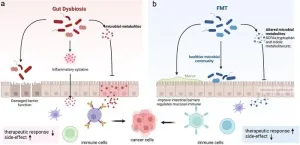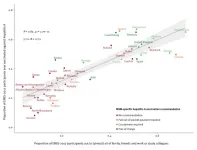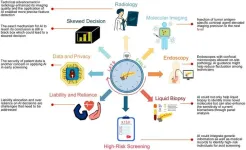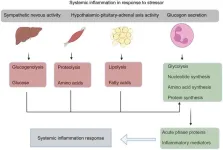(Press-News.org) “It’s necessary to consider the full life cycle of plastics, starting from the extraction of fossil fuel and the primary plastic polymer production” says lead article writer Patricia Villarrubia-Gómez at Stockholm Resilience Centre.
Plastics are not as safe and inert as previously thought. The new research article written by an international team of researchers uses the planetary boundaries framework to structure the rapidly mounting evidence of the effects of plastics on the environment, health and human wellbeing.
500 million tons of plastics are now produced yearly but only nine percent get recycled globally. Plastics are everywhere: from the top of Mount Everest to the deepest part of the Mariana Trench.
Through a synthesis review of the scientific literature on impacts of plastics in the natural environment, the research team shows that plastics pollution is changing the processes of the entire Earth system, and affects all pressing global environmental problems, including climate change, biodiversity loss, ocean acidification, and the use of freshwater and land.
The paper “Plastics pollution exacerbates the impacts of all planetary boundaries” emphasizes the need to consider the complexity of plastics. As synthetic polymer-based materials associated with thousands of other chemicals, their impacts occur throughout the full life cycle of these products and materials.
“Plastics are seen as those inert products that protect our favorite products, or that make our lives easier that can be “easily cleaned-up” once they become waste. But this is far from reality. Plastics are made out of the combination of thousands of chemicals. Many of them, such as endocrine disruptors and forever chemicals, which pose toxicity and harm to ecosystems and human health. We should see plastics as the combination of these chemicals with which we interact on a daily basis,” says PhD Candidate Patricia Villarrubia-Gómez at Stockholm Resilience Centre at Stockholm University.
Until recently, the scientific community has mostly studied these impacts separately, without addressing interactions between them. Also, public discourse and policy tend to address plastics as mainly a waste problem.
“The impacts of plastics in the Earth system are complex and interconnected, and this work clearly demonstrates how plastics are acting to destabilize the system,” says co-author associate professor Sarah Cornell, at Stockholm Resilience Centre at Stockholm University.
The team suggests a set of control variables that can be used together to include plastics pollution in the operational use of the Planetary Boundaries framework. Their impact pathway approach considers impacts and indicators at three main stages in the full life cycle of plastics: raw material extraction, plastics production and use; environmental release and fate; and Earth system effects.
“We emphasize the need to account for impacts at all stages along the life cycle of plastics, rather than looking for a single quantified planetary boundary threshold. We propose a set of control variables that together allow us to better understand and control plastics pollution,” says Patricia Villarrubia-Gómez.
The researchers examined the publicly available data on plastics production. In 2022 (the most recent data), at least 506 million tons of plastics were produced worldwide, with an accumulative 11 090 million tons of plastics produced from 1950 to 2022. The researchers note that there are major challenges in obtaining data on plastics production and use to make these calculations.
Data reporting relates to different polymer types, with insufficient standardization, lacking methodological detail and metadata about their sources and assumptions. Transparent and consistent aggregation and uncertainty assessments are not possible, hindering research and policy responses alike.
However, the available evidence shows clearly how plastics contribute to environmental problems up to the planetary scale, both directly and via knock-on biophysical interactions and cumulative effects.
Many people worldwide already face crisis conditions due to the breached planetary boundaries. Understanding the systemic interactions of plastics in the planetary boundaries framework can inform strategies for more sustainable responses, as an integrative part of climate change, biodiversity and natural resource-use policy.
“We now find plastics in the most remote regions of the planet and in the most intimate, within human bodies. And we know that plastics are complex materials, released to the environment throughout the plastics life cycle, resulting in harm in many systems. The solutions we strive to develop must be considered with this complexity in mind, addressing the full spectra of safety and sustainability to protect people and the planet,” says co-author of the paper, professor Bethanie Carney Almroth at University of Gothenburg.
As the international Plastics Treaty negotiations approach closure, the research team calls for experts and policymakers to shift away from considering plastics pollution as merely a waste management problem, and instead to tackle material flows through the whole impact pathway. This approach lets Earth system effects of plastics be detected, attributed and mitigated in a timely and effective way.
END
New study: Plastics pollution worsen the impacts of all Planetary Boundaries
2024-11-07
ELSE PRESS RELEASES FROM THIS DATE:
Long-term risks from prostate cancer treatment detailed in new report
2024-11-07
The risks of adverse effects and complications from treatment for prostate cancer are substantial and continue for years after treatment ends. The largest comprehensive analysis reporting long-term risks from such treatment relative to the risks faced by a control group of untreated men has just been published in the journal JAMA Oncology.
In the 12 years following treatment, men whose initial treatment was a prostatectomy (removal of all or part of the prostate) had a risk of urinary or sexual complications ...
Does more virtual care mean more low-value care? Study suggests no
2024-11-07
Before 2024 ends, Congress will decide whether to keep or change rules about telehealth, or let them expire. And even though the decision will focus on Medicare’s payment for virtual patient care, it will likely impact telehealth access for people with other kinds of health insurance too.
Now, a new University of Michigan study suggests that policymakers can rest easier about one of the top worries about telehealth: that virtual care will drive up the use of tests and scans that patients don’t need, wasting money and resources.
In fact, the study shows that low-value care didn’t rise faster at primary care practices that used telehealth the most, compared with those ...
City of Hope Research Spotlight, October 2024
2024-11-07
City of Hope® Research Spotlight offers a glimpse at groundbreaking scientific and clinical discoveries advancing lifesaving cures for patients with cancer, diabetes and other chronic, life-threatening diseases. Each spotlight features research-related news such as recognitions, collaborations and the latest research defining the future of medical treatment.
This roundup highlights the biology behind our sense of smell, real-world data that can be used to refine esophageal cancer treatment guidelines, a potential new approach to treating patients with type 2 diabetes, a new way to target pancreatic cancer ...
Increased focus on comorbidities, socioeconomic factors would help improve health equity for people with COPD
2024-11-07
Miami (November 7, 2024) – Health care providers treating people with COPD also need to focus on the person’s socioeconomic factors, along with considering their additional health conditions or comorbidities, according to a new article. The article is published in the September 2024 issue of Chronic Obstructive Pulmonary Diseases: Journal of the COPD Foundation, a peer-reviewed, open-access journal.
Chronic obstructive pulmonary disease (COPD) is an inflammatory lung disease, comprising several conditions, including chronic bronchitis and emphysema, and can be caused by genetics ...
Gut dysbiosis and fecal microbiota transplantation in pancreatic cancer: Current status and perspectives
2024-11-07
Pancreatic ductal adenocarcinoma (PDAC) is recognized as one of the most lethal cancers, with an estimated five-year survival rate of approximately 10%. This poor prognosis is largely attributed to the challenges in early diagnosis, aggressive tumor biology, and limited treatment options. Most PDAC cases are diagnosed at advanced stages due to its typically asymptomatic onset, making only a small percentage of patients eligible for potentially curative surgical resection. In recent years, increasing attention has been paid to the role of gut microbiota dysbiosis in PDAC, as ...
Prevalence of unrecognized cognitive impairment in socially and economically vulnerable older adults is high
2024-11-07
INDIANAPOLIS – One of the first studies to investigate the prevalence of unrecognized cognitive impairment among patients seen at Federally Qualified Health Centers, has found that it is ubiquitous, especially among minoritized older adults. These facilities provide primary care and preventive services regardless of ability to pay or health insurance status to more than 30 million patients, including a growing number of older adults.
Early and equitable detection of cognitive impairment can benefit patients and their families. Delaying diagnosis leads to poor health outcomes for patients ...
Men who have sex with men in Europe still vulnerable to hepatitis A and B, highlighting need for public health action and support
2024-11-07
Research analysing European survey data from 113,884 men who have sex with men (MSM) and published in Eurosurveillance indicates that while most MSM have a basic understanding of viral hepatitis, only 44% report having been vaccinated against both hepatitis A and B. The data highlight notable immunisation gaps despite available vaccination and recommendations. Strong public health support and creating an open environment that enables MSM to follow recommendations will be crucial to reduce outbreaks among MSM and eliminate hepatitis B.
Men who have sex with men are more likely to get infected with ...
Cancer genetic risk assessment guidelines expand to meet growing understanding of hereditary risk
2024-11-07
PLYMOUTH MEETING, PA [November 7, 2024] — The National Comprehensive Cancer Network® (NCCN®)—an alliance of leading cancer centers focusing on maintaining evidence-based expert consensus driven guidelines for care—announces the publication of the expanded NCCN Clinical Practice Guidelines in Oncology (NCCN Guidelines®) for Genetic/Familial High-Risk Assessment: Breast, Ovarian, Pancreatic, and Prostate. This closely follows the recent publication of the expanded NCCN Guidelines® for Genetic/Familial High-Risk Assessment: Colorectal, Endometrial, and Gastric.
Additional cancer types were added to the title and content for both guidelines. ...
Advances in screening and early diagnosis of pancreatic cancer
2024-11-07
Pancreatic cancer (PC) presents substantial diagnostic challenges due to its aggressive nature and lack of early symptoms, leading to late detection and poor prognosis. According to recent cancer statistics, PC ranks as the fourth leading cause of cancer deaths globally, with increasing incidence, particularly in high-risk regions such as China. Factors such as a shortage of specific and reliable screening markers, along with a lower prevalence in the general population, make effective large-scale screening a formidable tasko assess advancements in diagnostic techniques, artificial intelligence integration, biomarker discoveries, ...
Metabolic dysregulation and metabolite imbalances in acute-on-chronic liver failure: Impact on immune status
2024-11-07
Acute-on-chronic liver failure (ACLF) is a life-threatening condition characterized by acute deterioration of liver function in patients with pre-existing chronic liver disease. It is often accompanied by multiorgan failure and systemic inflammation, with high short-term mortality rates. The triggers for ACLF include bacterial infections, acute alcoholic hepatitis, and ischemic hepatitis, leading to the release of pro-inflammatory mediators. These systemic inflammatory responses result in immune dysfunction, contributing to the progression of the disease.
Recent research has emphasized the metabolic changes ...









